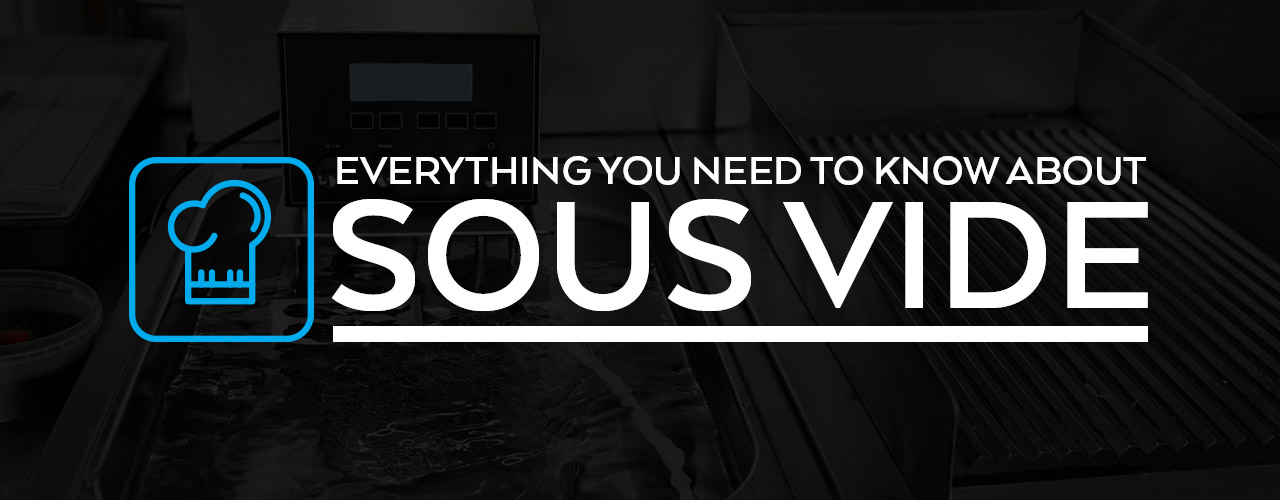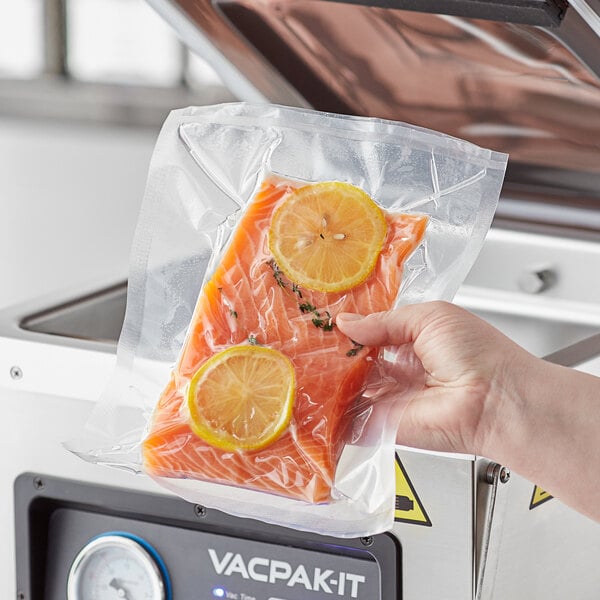
Sous vide is a French term meaning "under vacuum.” It is also the name for a cooking process where chefs slow-cook vacuum-sealed food in a water bath. Sous vide cooking is precise, requires minimal labor, and can reduce food waste. In the wake of staffing shortages and rising prices, reducing overhead costs and cutting back on labor are top priorities for restauranteurs. Keep reading to learn more about the sous vide cooking technique and how it can help your restaurant. We explain how to sous vide, the equipment needed, and provide a sous vide time and temperature chart.
Shop All Commercial Sous Vide Immersion CirculatorsSous Vide Cooking Tutorial
Watch our video to learn how to cook a steak with a sous vide machine.
What Is Sous Vide Cooking?

Sous vide cooking is a food preparation method where chefs place an immersion circulator into water to slow-cook vacuum-sealed food. The immersion circulator offers precise temperature control, so the food cooks consistently throughout. Developed in the mid-1970s by French chefs Bruno Goussault and George Pralus, sous vide cooking is now a fixture in many commercial kitchens.
This relatively foolproof method will cook everything from game meats to fruit. It can be executed by any member of your staff, democratizing chef stations. With the proper equipment and basic technical knowledge, your restaurant will soon be producing delicious sous vide dishes.
How to Pronounce Sous Vide
Sous vide is pronounced as sue-veed.
What Is a Sous Vide Machine?

A sous vide machine, also known as an immersion circulator, keeps your cooking water at a constant temperature by circulating the water through heated metal coils in the unit. Immersion circulator heads easily attach to water bath bins.
Sous Vide Cooking Equipment
There are a few pieces of equipment you will need to cook sous vide. Discover all the essential sous vide cooking elements below
- Immersion Circulator: This keeps your cooking water at a constant temperature and offers adjustable clamps so you can easily attach it to your water bath bin.
- Heat-Resistant Storage Container: This will hold the water and food bag you'll use to cook sous vide.
- Commercial Vacuum Sealer: This is to package your food before placing it in the water bath. Simply place your ingredients into the bag and use the commercial vacuum sealer to vacuum out any extra air, and seal it tightly.
- Vacuum Sealer Bags: These are to hold your ingredients. Most vacuum packaging bags are made of polyethylene, which is considered safe plastic. Avoid cheaper plastic wraps, because they are often made of PVC and may leak chemicals into your food.
- Pan (optional): Depending on the meal, you may want to place the food product on a hot pan to caramelize the outside and give it a browned, crisp look.
How to Sous Vide

The fail-proof sous vide cooking method can be accomplished by any staff member. It’s perfect for preparing ready-to-serve entrees and is a great tool for advanced food preparation. Check with your local health department regarding regulations for sous vide cooking. Many municipalities require a HACCP plan approval. Once you're in accordance with your local regulations, follow these simple steps to learn how to sous vide.
- Season Your Food - Rub your food items in spices and seasonings. You will seal your seasonings in with the food, allowing them to penetrate and enhance it while it cooks.
- Add Food to the Bag - Add your seasoned food into a food-grade vacuum sealer bag and seal it closed. Consider adding larger aromatics like whole bay leaves, dried chili peppers, or sprigs of rosemary to the bag before sealing it. Position them against the protein.
- Seal the Bag - Follow the manufacturer's instructions on how to use your vacuum sealer to close your food-grade sealer bag. You must press out as much air as possible before sealing your bag.
- Create a Water Bath - Fill a heat-resistant storage container with water.
- Set up Your Immersion Circulator - Place your immersion circulator in the water bath per manufacturer guidelines. Select the time and temperature appropriate for the item you’re cooking. You can check out our sous vide time and temperature guide below.
- Add Your Vacuum-Sealed Bag to the Water - Once the water comes to temperature, you can drop it directly into the water.
- Optional: Sear the Food - If you’d like to brown a steak or short ribs before serving them, you should remove them from the bag and dry them thoroughly with paper towels. Then, sear them in a hot pan. The meat is already fully cooked, so you should sear it for less than two minutes per side. Caterers can sous-vide steaks in advance and then reheat them by searing them right before their event.
- Serve or Store - Your food is ready to serve. However, sous vide cooking is a wonderful meal prep tool. To store your sous vide cooked food for later use, add the bag to ice water to stop the cooking process and cool it through the temperature danger zone. Then add the bag to your refrigerator, and it will remain fresh for up to 7 days. If you add it to your freezer, it will remain in good condition for a year.
How to Infuse Foods with Sous Vide
Many chefs use sous vide methods to infuse oils, alcohol, and other liquids with creative and unique flavors. For example, you could combine spices or herbs with alcohol, vacuum seal it into a bag, and prepare it sous vide-style at a high temperature for quick and easy infusion. Infused liquids should be allowed to heat in the water bath for 1 to 2 hours. Once removed, you should place the bag in an ice bath for at least 15 minutes. To finish, strain your liquid and store it in a sealed container. You can also add dry or liquid condiments to food during vacuum packing for enhanced infusion and marination.
What Can You Sous Vide?
While sous vide works best for cooking meat and fish due to their lower required cooking temperature, you can also sous vide a variety of other foods. These include (but are not limited to) french fries, vegetables, fruits, and infused alcohol and oil. Sous vide poached eggs come out perfectly and can be made in bulk.
Sous Vide Benefits

Cooking food through the sous vide method comes with a variety of benefits that include increased free time, higher taste quality, and improved food safety. By controlling heat and temperature, you eliminate the guesswork of evaluating steak doneness levels and recipe cook times. Below we have outlined the key benefits of sous vide cooking.
- Set It and Forget It - Cooking sous vide gives you the freedom to vacuum pack your food, place it in water, set the temperature, and walk away. Unlike traditional cooking methods where you must watch and check on your food, items prepared using sous vide will cook to perfection and free up your chef's hands for other tasks.
- Energy Efficient - Using the sous vide method can cut down on energy costs in your establishment. For sous vide cooking, you'll only need one small piece of equipment (the immersion circulator) that uses a single outlet.
- Eliminates Overcooking - Another benefit of sous vide is it makes it virtually impossible to overcook food. Sous vide cooks by bringing food up to the exact temperature of the water bath, so your ingredients will be unable to cook at a higher degree than the water's specified temperature. The immersion circulator makes it impossible for the water to cool beyond the set temperature, which leads to even and consistent cooking.
- Better Taste - Thanks to the water cooking medium, your food will also retain its moisture and tenderness without shrinking in size. Natural juices are trapped in the bag with your food, which leads to a marinating effect and enhances their taste. When the cooking cycle is complete, the result is moist and juicy.
- Reduces Prep Time - Sous vide allows you to prepare foods in advance and quickly sear or heat them before serving. All your ingredients go into the same bag, and when you are done, all that is left to do is sear it for color before serving. You can also use sous vide for advanced meal preparation. After your bagged meal has been cooked in the water bath, it can be stored in the refrigerator for a later date. Simply reheat the meal when you’re ready to serve.
- Reduces Risk of Contamination - A critical concern in restaurants is preventing cross-contamination. Fortunately, the length of time it takes for foods to cook via sous vide practically eliminates the risk of contamination, since the water essentially pasteurizes your food due to the high and consistent temperatures.
Back to Top
Sous Vide Cooking Times
Below we have helpful tables you can follow while you explore the best foods to cook sous vide. You can also use the links below to jump to a particular type of food.
 Cooking Chicken Using Sous Vide
Cooking Chicken Using Sous Vide
You can use sous vide to prepare delicious and tender chicken. It is an effective cooking method for both light and dark meat, making it ideal for all your restaurant's poultry dishes. For recommended times and temperatures when cooking chicken sous vide, check out the table below:
| Type of Meat | Doneness | Temperature | Time |
| Light Meat | Supple | 140 degrees F | 2 hours |
| Tender | 149 degrees F | 1 hour | |
| Well Done | 167 degrees F | 1 hour | |
| Dark Meat | Tender | 149 degrees F | 1 hour 30 minutes |
| Falling off the Bone | 167 degrees F | 1 hour 30 minutes |
 Cooking Fish Using Sous Vide
Cooking Fish Using Sous Vide
From salmon to tilapia and everything in between, sous vide is an excellent way to cook a variety of fish. Be sure to filet and portion before you vacuum seal; a whole fish will not cook evenly. For recommended times and temperatures when preparing fish filets around 1.5 inches thick, check out the table below:
| Type of Meat | Doneness | Temperature | Time |
| Fish | Tender | 104 degrees F | 40 minutes |
| Flaky | 122 degrees F | 40 minutes | |
| Well Done | 140 degrees F | 40 minutes |
 Cooking Beef Using Sous Vide
Cooking Beef Using Sous Vide
Sous vide is an exceptional way to prepare beef to ensure it is perfectly cooked every time, whether it is filet mignon, roast, or brisket. As opposed to traditional methods like pan-searing or grilling, sous vide steaks will not be scorched or have overcooked outer edges. For recommended times and temperatures when cooking sous vide beef, check out the table below:
| Cut | Doneness | Temperature | Time |
| Steak | Rare | 129 degrees F | 1 hour 30 minutes |
| Medium Rare | 136 degrees F | 1 hour 30 minutes | |
| Well Done | 158 degrees F | 1 hour 30 minutes | |
| Roast | Rare | 133 degrees F | 7 hours |
| Medium Rare | 140 degrees F | 6 hours | |
| Well Done | 158 degrees F | 5 hours | |
| Tough Cuts | Rare | 136 degrees F | 24 hours |
| Medium Rare | 149 degrees F | 16 hours | |
| Well Done | 185 degrees F | 8 hours |
 Cooking Pork Using Sous Vide
Cooking Pork Using Sous Vide
You can also use the sous vide method to easily cook pork chops and roasts or tougher cuts like pork belly and pork shoulder. Cooking pork sous vide-style will even eliminate chewy or tough spots in your meat. For recommended times and temperatures when cooking pork sous vide, check out the table below:
| Cut | Doneness | Temperature | Time |
| Chops | Rare | 136 degrees F | 1 hour |
| Medium Rare | 144 degrees F | 1 hour | |
| Well Done | 158 degrees F | 1 hour | |
| Roast | Rare | 136 degrees F | 3 hours |
| Medium Rare | 144 degrees F | 3 hours | |
| Well Done | 158 degrees F | 3 hours | |
| Tough Cuts | Rare | 144 degrees F | 16 hours |
| Medium Rare | 154 degrees F | 12 hours | |
| Well Done | 185 degrees F | 8 hours |
 Cooking Fruits and Vegetables Using Sous Vide
Cooking Fruits and Vegetables Using Sous Vide
You can even use sous vide to prepare delicious fruits and vegetables. For recommended times and temperatures when cooking fruits and vegetables using sous vide, check out the table below:
| Type of Food | Temperature | Time |
| Green Vegetables | 185 degrees F | 5 minutes |
| Squash | 185 degrees F | 1 hour |
| Potatoes & Root Vegetables | 185 degrees F | 1 hour |
| Fruit (Warm & Ripe) | 154 degrees F | 1 hour 45 minutes |
| Fruit (Soft for Purees) | 185 degrees F | 30 minutes |
 Cooking Eggs Using Sous Vide
Cooking Eggs Using Sous Vide
Sous vide cooking can be used to prepare eggs in a variety of different styles. For recommended times and temperatures when cooking eggs using sous vide, check out the table below:
| Consistency | Temperature | Time |
| Runny white and runny yolk | 140 degrees F | 31 minutes |
| Runny white and medium yolk | 140 degrees F | 1 hour and 15 minutes |
| Runny white and firm yolk | 140 degrees F | 7 hours and 45 minutes |
| Medium white and runny yolk | 151 degrees F | 20 minutes |
| Medium white and medium yolk | 151 degrees F | 26 minutes |
| Medium white and firm yolk | 151 degrees F | 40 minutes |
| Firm white and runny yolk | 185 degrees F | 12 minutes |
| Firm white and medium yolk | 185 degrees F | 13 minutes |
| Firm white and firm yolk | 185 degrees F | 14 minutes |
If you’d like a physical copy of these sous vide cooking times and temperatures to keep on hand, click the link below to access a printable version.
Printable VersionSous Vide Temperature Chart
The guide below features the benefits of sous vide cooking, the equipment needed, and helpful charts on sous vide cooking times for the most popular foods you may find in your kitchen.

Sous vide cooking has become one of the most celebrated ways to prepare food in commercial kitchens. Part of its popularity is that it doesn't require expensive equipment and can be performed by any member of your staff. If you're looking for a consistent, easy, and energy-efficient method to prepare food at your restaurant, sous vide is a perfect choice.





